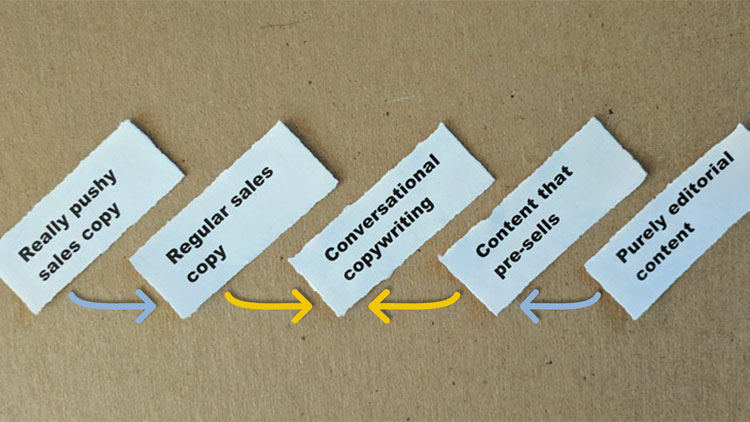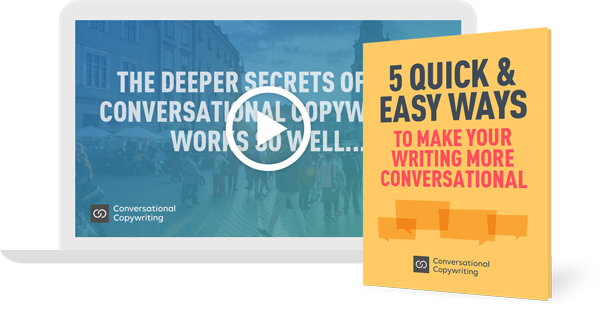
A few people have asked me whether conversational copywriting is simply a different name for web content.
That’s a reasonable question.
The short answer is no. But with a few shades of yes.
Take a look at the labels in the image above and we’ll figure out exactly how and why conversational copywriting sits where it does – right in the middle, between sales copywriting and editorial content.
Step by step…
Over on the far left we have the “really pushy sales copy”.
This represents the kind of in-your-face sales pitch you would expect from a used car salesman, a late-night infomercial presenter or in some of those spammy emails that make their way into your inbox.
This is hard-selling copy that can work for certain product or service categories to particular audiences.
Fast-paced and brimming with urgency, it can also feel just a tad deceptive and manipulative. (Or a big tad.)
On the far right we have purely editorial content.
This kind of content is written by traditional journalists and brought to us by responsible publishers, offline and online.
This is old-school journalism, where the writer attempts to be reasonably objective and present both sides of an issue, without favoring either side.
Truth be told, this kind of “high-trust” journalism is something of a rarity these days.
It seems like everyone has an axe to grind
OK… moving a little more to the center now…
Next in from the left is what I call regular sales copy.
This is the kind of copy you’ll find everywhere you look, every waking moment of your day.
We’re hit with sales messages from every direction. On TV, radio, billboards, newspapers and other old-school broadcast media.
And on our computers, tablets and smartphones.
This kind of sales copy is certainly trying hard to be persuasive, but without the brashness and pushiness of the used car salesman.
We recognise it as sales copy. We know we’re being sold to.
And there’s so much at it, we’ve become pretty adept at ignoring it and filtering it out.
One in from the right is content that pre-sells.
Content that pre-sells is not purely editorial. But it still works to hold and build the reader’s trust. So it’s not overtly promotional either.
For example, you might write some sponsored content in the form of a post, article or review that is paid for. This rarely takes the form of a direct sales pitch, but you’re definitely working to warm up the reader to a point where he or she is more likely to buy.
Emails, posts, articles and social media updates may also form parts of an online sales funnel. Again, there’s nothing overly promotional going on. But simply through sharing information in a carefully constructed sequence, and building trust, you’re moving the reader to within hailing distance of the shopping cart.
The whole idea of content that pre-sells… sometimes very gently, and sometimes with a little more deliberation… lies at the heart of content marketing.
And now we’ve hit the center point, with Conversational Copywriting.
Conversational copywriting is a hybrid of sales copy on one side, and content that pre-sells on the other.
It sits in the middle, with attributes of both, but leans a little more into the copywriting side.
Good conversational copywriting closes sales, but still feels like content.
It gets people to buy, but without being pushy.
It sells, but without losing trust.
It makes you feel like you’re talking with a friend who tries to persuade you to take a certain course of action, but still has your best interests at heart.
Here’s why conversational copywriting hits the sweet spot for online copywriters and marketers…
The web is a noisy space, brimming with distractions.
Creating great content alone won’t break through that clutter. It will rarely close the sale on its own.
But the web is also a place where people have a highly developed sensitivity to BS.
As a result, conventional, in-your-face sales approaches can cause those defenses to slam closed like the shutters on a window.
So… we have a challenge.
We need a sales approach that is loud enough and persuasive enough to break through the noise, but not so loud that is causes those shutters to slam closed.
That approach is conversational copywriting.
Conversational Copywriting is selling without shouting.
And it’s the future of selling online.
You can build your expertise in Conversational Copywriting now, or try catching up later. Find out about the course here…
